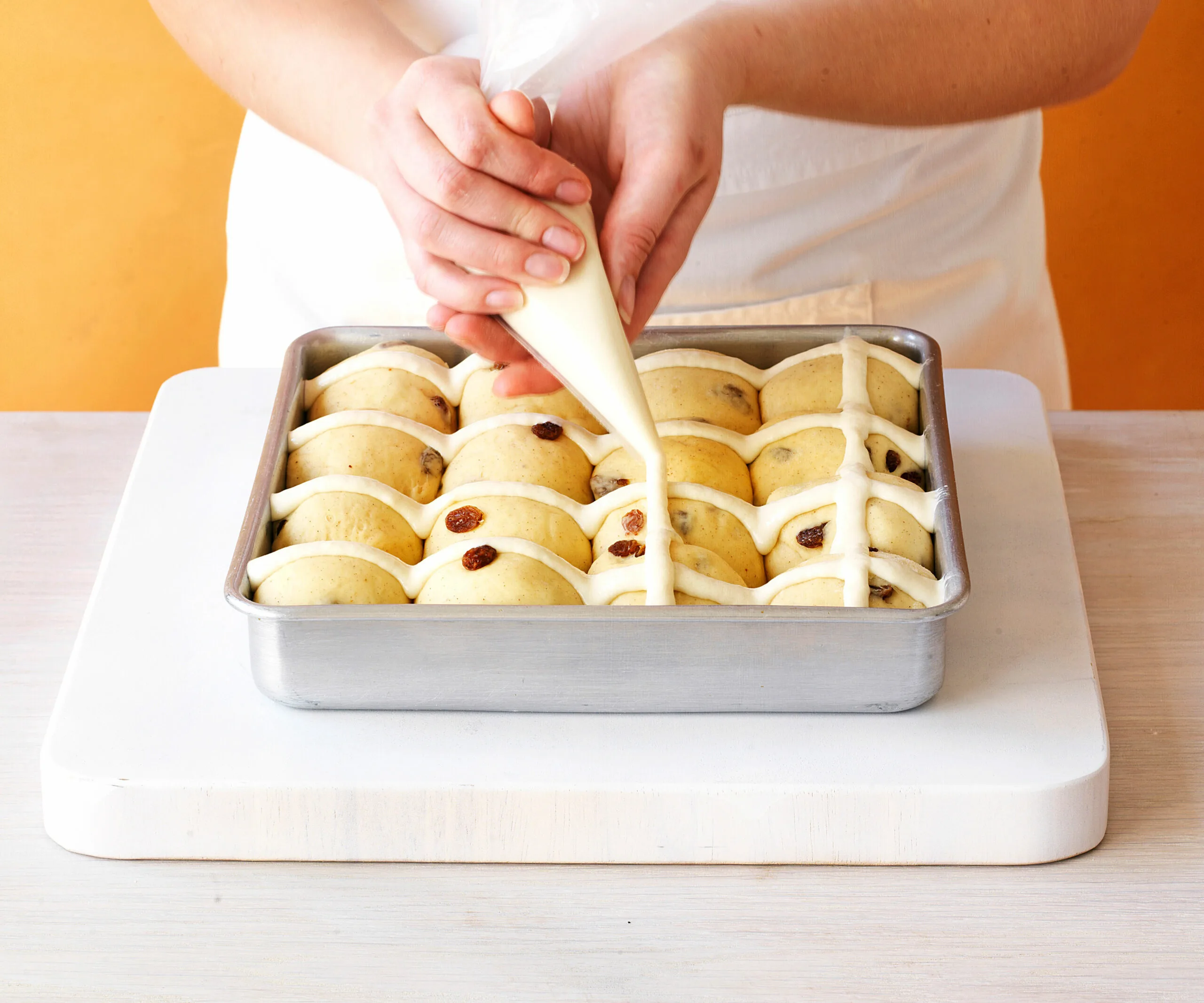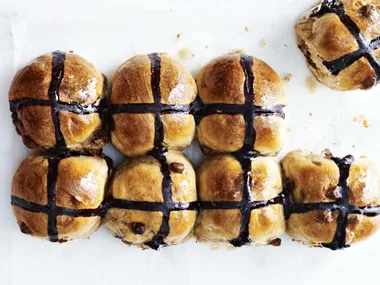Try our easy hot cross bun recipe for delicious results.
Nothing says “Easter” like biting into a tender hot cross bun, shining with glaze and jewelled with delicious dried fruit. While it might be easy to swing past the shops to buy some ready-made hot cross buns this Easter, we can’t encourage you enough to consider making our easy hot cross buns recipe at home instead. When the smell of baking bread and cinnamon fills your kitchen, and butter melts perfectly on a bun fresh from the oven, we can promise you won’t regret it!
How to make hot cross buns
In order to make the softest, most delicious hot cross buns, this recipe relies on slow proving with just a small amount of yeast. In this recipe we prove the dough three times before baking. This gives the yeast plenty of time to work in the dough, creating a light and chewy texture that just can’t be beat.
We also used bread flour, which is higher in gluten than plain flour, so produces a better texture in the bun. Plain flour can be substituted if you can’t find bread flour.
Looking for more hot cross bun recipes?
Ingredients
Method
Bring milk to the boil in a small saucepan; remove from heat. Add honey, oil and butter; stir until combined.
Whisk juice and yeast in a large bowl until dissolved. Add egg and rind, then currants and sultanas. Add combined flour, cinnamon and salt, then milk mixture; using your hands or a dough scraper, mix together until combined. Cover with plastic wrap; stand in a warm place for 30 minutes or until the dough doubles in size.
Lightly knead dough on a lightly oiled or floured surface for 10 seconds. Return to bowl, cover; stand in a warm place for 1 hour or until risen by half.
Divide the dough into 16 pieces (each a little over 90g/3 ounces); shape into balls. Place in a large square cake pan or baking dish lined with baking paper or greased, in four rows of four. Cover; stand in a warm place for 30 minutes or until risen by half.
Preheat oven to 200°C/400°F.
Make flour paste: Combine flour and sugar in a small bowl. Gradually mix in enough water to make a smooth paste.
Place flour paste mixture into a small piping bag fitted with a small plain tube. Pipe crosses onto the buns.
Bake buns for 25 minutes or until buns are browned and sound hollow when tapped. Cool in pan.
Make glaze: Combine ingredients in a small saucepan; stir over low heat, without boiling, until sugar and gelatine dissolve.
Transfer buns to a wire rack and brush tops with glaze.
Cooked buns suitable to freeze. Not suitable to microwave.
We used a 23cm (9-inch) square cake pan for the buns. A plastic dough/pastry scraper is handy for mixing the dough and cutting it into the 16 pieces.
Bread flour is higher in gluten than plain flour, so produces a better-textured bun. Bread flour goes under various names: “strong”, “baker’s” or “bread”. Plain (all-purpose) flour
can be substituted.
The perfect warm place to prove yeast dough is a windowsill in sunlight, or on an open oven door, with the oven set at a low temperature.
For fresh buns on Good Friday morning, make and shape the dough according to the recipe, place on trays, then cover loosely for their last proving in the refrigerator overnight. Pipe crosses, then bake.
Test Kitchen tips
Tips for making this hot cross bun recipe

The first proving comes immediately after combining the ingredients of the dough (full ingredients and method are at the bottom of this page). Covered with plastic wrap and stood in a warm place, the dough should roughly double in size within about an hour.
The perfect warm places to prove yeast dough are a windowsill in sunlight, or on an open oven door, with the oven set at a low temperature.
Once the dough is risen there is no need to “knock it down” by punching it. Instead, simply knead it for a few seconds and return it to the bowl to prove for another hour.

Once the dough has risen a second time, divide it evenly into 16 rolls.
For a bun with a softer crust, arrange the buns in rows of four inside a square 23cm cake pan. If you prefer a bit more of a crust, arrange the buns on a baking tray in four rows of four.

The final proving takes just 30 minutes, the perfect amount of time to whip up the flour paste to pipe the iconic crosses.
If you want to make fresh hot cross buns on Good Friday morning you can cover loosely for their last proving in the refrigerator overnight. Stand at room temperature for 45 minutes, pipe the crosses, then bake.

The buns only take 25 minutes to cook in the oven, so with 5 minutes left you can whip together the simple glaze.
You’ll know the buns are cooked if they sound hollow when lightly tapped. Once they’re cooked, turn them out onto a wire rack and brush with glaze.
Enjoy!
 Ben Dearnley
Ben Dearnley

